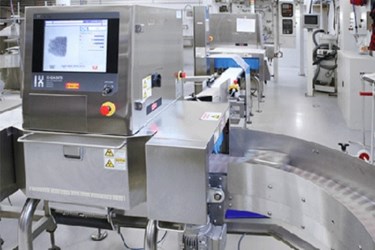How X-Ray Systems Are Refining Food Product Inspection
By Melissa Lind, contributing writer

X-Ray inspection systems help food processors and manufacturers to meet regulatory standards that are becoming increasingly stringent. While this is certainly a valuable asset, it may be trumped by the value it provides from a business perspective.
Perhaps the most-versatile and cost-effective means of detecting food contaminants, X-Ray inspection systems are helping food processors, producers, and manufacturers in more ways than a surface glance allows. The increasing affordability of advanced X-Ray equipment, along with improvements constantly being made in the technology, are changing the food industry for the better, making it safer, more efficient, and ultimately, more-financially rewarding.
The Need For X-Ray Inspection Systems
In the short-term, X-Ray systems can help manufacturers detect a wide variety of solid-body contaminants such as glass, metal, high-density plastic, stone, and bones. They can also identify cases of improper count, poor placement, and inadequate seal. Because the system is automated, rejects can be quickly identified and removed and in-process adjustments can be made. X-Ray inspection technology can help avoid line stoppages and reduce the chance of total batch loss and increase productivity as they can run at variable speeds and free up personnel to be used in other areas. In short, X-Ray inspection systems are a tool to bolster efficiency.
Food X-Ray Inspection Equipment: What You Should Know
In the long-term, as the systems can be used at virtually any point in manufacturing, processing, and packaging lines and are highly accurate for a variety of tasks, X-ray systems help to maintain high-quality standards and protect consumer loyalty.
Offering Speed And Safety
A major concern of many food and beverage makers regarding inspection systems is line speed. As time more often than not equates to money, processors can’t afford to reduce line speed and slow production. X-Ray systems can operate at variable speeds, including high-speed lines without an adverse effect on detection rate.
A second concern regarding X-Ray systems is radiation causing damage to products or health threats to employees. Newer X-Ray inspection systems have radiation exposure that is minute in comparison to maximum safety levels. The World Health Organization (WHO) has stated that food exposed to 10,000 Sievert (standard radiation unit) is not affected in quality, safety, or nutritional value. In contrast, food examined by an X-Ray detection system is exposed to an average of only 0.2 millisievert or 0.002 Sievert.
Case Study: X-Ray Inspection Ensures Food Safety For Food Service Manufacturer
In regard to the safety of employees, the average human is exposed to natural environmental radiation at an average range of 2.4 milli Sievert per year. An employee working 40 hours in a week, in direct contact with an X-Ray detection system used in the food industry would receive background radiation of about 2 milli Sieverts per year.
Advanced Detection Features
X-Ray inspection systems continue to advance to do more and more tasks. In addition to the ability to detect a wide variety of solid-body contaminants in a range of sizes, along with the ability to detect other packaging anomalies, newer systems have easier user-interface technology. These interfaces are equipped with advanced graphics and a variety of software solutions, such as multi-lane and multi-view ability, on-screen self-diagnosis, and increased accuracy in detection. Additionally, newer systems are networked. This allows for immediate correction of line issues by remote technicians and access to integrated data for real-time statistical monitoring.
Staying Up-To-Date
One of the recent developments in the food industry is the requirement for strict adherence to fat quantity and other nutritional standards. The newest X-Ray inspection systems can conduct fat-analysis using Dual Energy X-Ray Absorptiometry (DEXA) technology. This method is the most accurate and verifiable method of fat analysis available and enables manufacturers to meet the requirements of both the demanding consumer and concerned regulators. The addition of this type of analysis has also not affected speed or reduced efficiency.
Can Your Food Safety Plan Meet The Rigors Of FSMA’s Preventative Controls?
X-Ray technology for the food industry has shown itself to be adaptable, flexible, and durable. With changing trends in the food industry, X-Ray inspection equipment producers will need to continue to increase the capability of the systems to accommodate innovative packaging, analytical methods, and data visibility so that tomorrow’s food manufacturer can guarantee quality and compliance while using the system’s information to make decisions on the plant floor.
